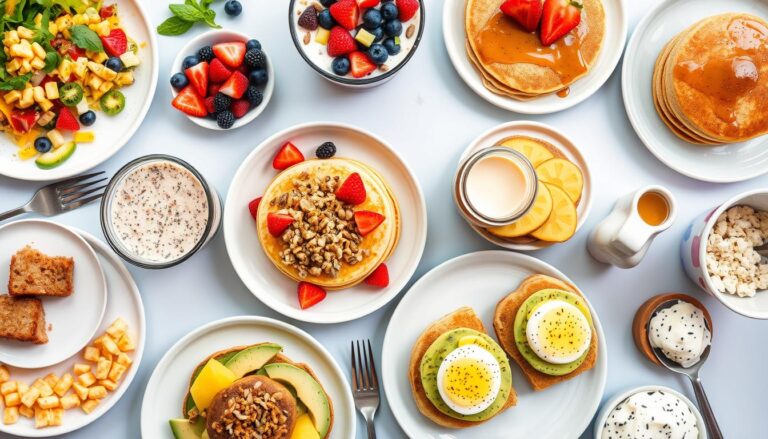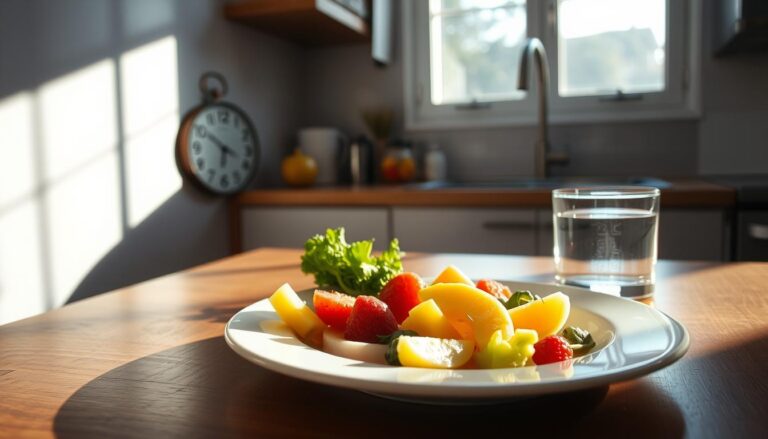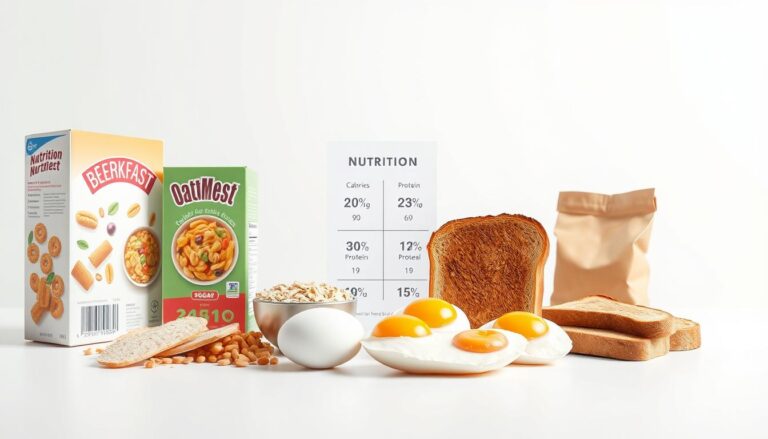What if the fastest way to feel fuller steady your energy and support your heart is not a new pill but a bold return to plants are you ready to test that idea?
Across the United States a fresh health trend is taking off fiber maxxing. At its core this nutrition craze focuses on maximizing total fiber from whole foods and when needed targeted supplements. It speaks to a simple gap most Americans average only 15–18 grams per day well below the Adequate Intake.
This movement links everyday choices to big goals. People want better digestion easier weight control and stronger cardiometabolic health. The premise fits modern healthy eating more legumes, whole grains fruits vegetables nuts and seeds with smart tracking to keep progress real.
In the pages ahead we cut through hype and answer a key question many are asking What exactly is Fiber Maxxing the new nutrition craze? You will see how the approach differs from a standard high fiber plan where it shines, and how to ramp up intake safely without discomfort.
Think practical steps evidence you can trust, and tools you can use today. If you have wondered whether a focused push on fiber can pay off this guide offers a clear balanced start.
Key Takeaways
- Fiber maxxing is a rising health trend that emphasizes high fiber intake from whole foods first.
- Most Americans fall short on fiber, making this nutrition craze timely for better healthy eating.
- Goals include digestive comfort satiety for weight management and heart and metabolic support.
- Expect guidance on soluble and insoluble fiber plus fermentable types that feed the gut microbiome.
- Safe strategies help you increase fiber without bloating using hydration, gradual steps, and variety.
- Clear tips on tracking intake and choosing foods make daily habits easier and more sustainable.
Defining Fiber Maxxing in Today’s Nutrition Trends
Fiber Maxxing means setting a clear plan to raise daily fiber intake far above the U.S. average while keeping meals enjoyable and practical. It blends whole-food choices with simple tracking to unlock dietary fiber benefits without guesswork. In today’s nutrition trends it acts as a focused health trend rather than a vague goal.
The approach centers on what you add not what you cut. Legumes whole grains vegetables fruits nuts, and seeds anchor the plan with optional clinically studied supplements when foods alone fall short.
How Fiber Maxxing differs from a standard fiber-rich diet
A standard fiber rich diet suggests eat more plants. Fiber Maxxing sets numbers and methods. It tracks grams per day balances soluble and insoluble types, and favors viscous and fermentable fibers for satiety and microbial support.
It also paces increases to protect comfort. Most people step up by 3–5 grams every few days and pair changes with water. This structure helps turn nutrition trends into steady habits.
Core principles that drive this health trend
- Whole-food-first sourcing with legumes, oats barley berries leafy greens nuts, and seeds.
- Gradual titration: add 3–5 grams every few days to support tolerance and sustained fiber intake.
- Hydration with each meal to aid movement and reduce GI strain.
- Distribution across breakfast lunch dinner, and snacks for satiety and stable energy.
- Diversity of fiber types soluble insoluble viscous, and fermentable to broaden dietary fiber benefits.
Why fiber is having a moment in healthy eating
Microbiome science has reached mainstream audiences, making fiber a leading health trend. People want foods that help fullness weight control, and metabolic balance, and a fiber rich diet fits that demand.
Clearer labels and high-volume, low-calorie meals on social media make tracking fiber intake easier. The result is a practical path to better meals that aligns with modern nutrition trends.
| Aspect | Standard Fiber Rich Diet | Fiber Maxxing | Why It Matters |
|---|---|---|---|
| Goal Setting | General eat more fiber advice | Quantified targets grams/day and meal distribution | Improves adherence and highlights dietary fiber benefits |
| Fiber Diversity | Not always specified | Soluble, insoluble, viscous, fermentable emphasized | Broader effects on satiety, gut health, and glucose |
| Ramp-Up Strategy | Often abrupt | Gradual 3–5 g increases with hydration | Reduces GI discomfort and supports steady fiber intake |
| Food vs. Supplements | Food-first, limited guidance | Whole food first plus targeted use of psyllium or inulin | Allows precision when food alone is insufficient |
| Daily Rhythm | Varies by meal | Even spread across the day | Supports energy, fullness, and glycemic control |
What exactly is Fiber Maxxing the new nutrition craze?
Think of fiber maxxing as a practical way to pack more roughage into each calorie. The aim is simple design meals that front load fiber for better digestion steady energy and a fuller plate. In plain terms it blends healthy eating with smart meal design to support digestive health and help with fiber and weight loss.
What exactly is Fiber Maxxing the new nutrition craze? It is a pattern, not a strict diet. You build bowls soups, and snacks around beans, whole grains vegetables fruits, and seeds so each bite does more metabolic work. The approach favors foods that slow digestion and keep you satisfied.
Origins of the term and who popularized it
The phrase spread through nutrition podcasts, Reddit threads, and TikTok and Instagram posts. Evidence focused dietitians highlighted classic research from the National Institutes of Health and the American Heart Association to explain why fiber maxxing works.
Media voices like Michael Pollan and brands such as Kellogg’s and Bob’s Red Mill helped keep fiber in the spotlight by promoting whole grains and legumes.
Common goals digestive health satiety and metabolic support
- Digestive health more bulk and softer stools from insoluble and gel forming fibers.
- Fullness and fiber and weight loss viscous fibers slow gastric emptying helping you eat fewer calories without feeling deprived.
- Metabolic support soluble fiber can aid LDL-cholesterol reduction and steady post meal glucose.
People also look for steady energy and fewer cravings. These wins make healthy eating feel doable day after day.
How Fiber Maxxing fits within broader nutrition trends
Fiber maxxing aligns with Mediterranean and plant-forward styles from Oldways and the American Heart Association. It pairs well with volumetrics where high water high fiber foods deliver more volume per calorie. It stays flexible for omnivores vegetarians, and vegans, which has boosted appeal across the United States.
| Approach | Primary Focus | How Fiber Maxxing Integrates | Typical Foods |
|---|---|---|---|
| Mediterranean | Whole plants, olive oil, seafood | Emphasizes fiber density within meals | Lentils, farro, chickpeas, leafy greens |
| Volumetrics | Low calorie hig volume eating | Uses fiber to boost fullness per calorie | Vegetable soups, big salads, berries |
| Plant-Forward | Plants at the center of the plate | Targets specific fiber types for benefits | Oats, beans, apples, chia seeds |
| Metabolic Health | Glucose, lipids, satiety | Applies soluble fibers to steady responses | Oat bran, barley, psyllium, pears |
The Science of Dietary Fiber Benefits
Dietary fiber benefits reach from the gut to the heart. As nutrition trends evolve, scientists continue to map how fiber intake shapes digestion metabolism, and daily energy. High fiber foods also deliver vitamins and polyphenols which amplify the health benefits of fiber through a whole food matrix.
Soluble vs. insoluble fiber and their roles
Soluble fiber dissolves in water and forms a gel. Oats with beta-glucan, apples rich in pectin, and psyllium from Metamucil slow the rise in blood sugar after meals and help lower LDL cholesterol by binding bile acids. These dietary fiber benefits align with broader nutrition trends that favor steady energy.
Insoluble fiber does not dissolve. Wheat bran and many vegetables add bulk which supports regularity and stool form. Pairing both types in high fiber foods balances comfort and predictable digestion improving the health benefits of fiber without extreme diet shifts.
Gut microbiome short chain fatty acids and inflammation
When fiber reaches the colon, microbes ferment it into short-chain fatty acids such as acetate propionate, and butyrate. These compounds nourish the gut lining and help keep the barrier strong. They also influence immune signals that manage everyday inflammation.
This microbiome activity may shape appetite cues and satiety. Consistent fiber intake from high fiber foods like legumes barley, and bananas supports a diverse microbial community a key driver behind modern nutrition trends.
Cardiometabolic impacts cholesterol, glucose and blood pressure
Viscous soluble fibers show the clearest LDL cholesterol effects, especially when eaten as part of a heart-smart pattern that limits refined grains. Better post-meal glucose and insulin responses often follow reflecting core dietary fiber benefits that stack up over time.
Within a balanced diet higher fiber intake can modestly aid blood pressure. The health benefits of fiber extend beyond single nutrients because high fiber foods usually come packaged with potassium, magnesium, and antioxidants that support cardiometabolic balance.
Health Benefits of Fiber for Everyday Wellness
Everyday choices shape how we feel, move, and look. A balanced, fiber rich diet supports steady energy and simple, healthy eating habits. The health benefits of fiber touch many systems, helping people stay on track with realistic meals and routines.
Digestive health and regularity
Fiber adds bulk, softness, and consistency to stools, which supports digestive health day to day. This helps reduce the risk of constipation and can ease mild diarrhea by normalizing water content and transit time. With enough fluids and movement, these effects feel gentle and steady.
Population research links diverse, plant-forward eating with lower risks of diverticular disease and colorectal cancer. Whole grains beans fruits, and vegetables deliver varied fibers that work together to support the gut.
Fiber and weight loss through fullness and food volume
Viscous fibers swell in the stomach, slow digestion, and boost fullness. That’s one reason fiber and weight loss often go hand in hand when paired with calorie awareness. High fiber meals also allow a larger food volume at a lower energy density, a principle used in volumetrics.
Simple swaps like oats for refined cereal or lentils for part of the meat in chili can raise fiber while keeping flavor and satisfaction high. These shifts make healthy eating easier to maintain.
Immune and skin health connections via the gut axis
Fiber feeds gut microbes that produce short-chain fatty acids which may influence immune signaling and support the intestinal barrier. Many people notice calmer skin when their meals lean toward a fiber-rich diet rich in plants though responses vary by individual.
Colorful produce, nuts, seeds, and whole grains supply antioxidants and minerals alongside fiber. Together they form a daily pattern that supports resilience from the inside out rounding out the health benefits of fiber across seasons and lifestyles.
Daily Fiber Intake Recommendations for the United States
In the United States, interest in fiber sits at the center of a fast-moving nutrition craze and a broader health trend. Clear, practical fiber intake recommendations help set targets you can follow day to day without confusion.
Recommended intakes by age and sex
The Adequate Intake levels often cited for fiber intake are about 25 grams per day for adult women and 38 grams per day for adult men. After age 50 typical targets shift to about 21 grams for women and 30 grams for men, reflecting lower average energy needs.
Children and teens follow scaled goals tied to calories. As the nutrition craze grows these benchmarks offer a stable guide within the evolving health trend.
| Group | Daily Target g | Notes |
|---|---|---|
| Women 19–50 | ~25 | Adjust with activity and appetite |
| Men 19–50 | ~38 | Higher energy needs raise fiber intake |
| Women 51+ | ~21 | Lower energy needs with age |
| Men 51+ | ~30 | Maintain steady hydration |
| Children/Teens | Varies | Use 14 g per 1,000 kcal |
How to calculate your personal fiber needs
A simple method works across ages: aim for 14 grams of fiber per 1,000 calories. On a 2,000-calorie plan, target about 28 grams per day at 2,500 calories, aim for about 35 grams.
Track your usual intake for a week and compare. Small steady steps help align fiber intake with your routine while keeping this health trend sustainable.
Risks of too little and too much fiber intake
Too little fiber is linked to constipation lower diet quality and higher cardiometabolic risk. In the United States most people fall short of these fiber intake recommendations.
Jumping too fast can backfire. Rapid increases without enough fluids may cause gas, bloating or cramps, and could affect how some minerals or medications are absorbed. Increase gradually drink water, and adjust as your body adapts.
High-Fiber Foods to Power a Fiber Rich Diet
Build a plate that makes healthy eating simple. Mix textures and colors to raise fiber intake without fuss. Aim for variety so you cover soluble insoluble, and fermentable fibers across the day.
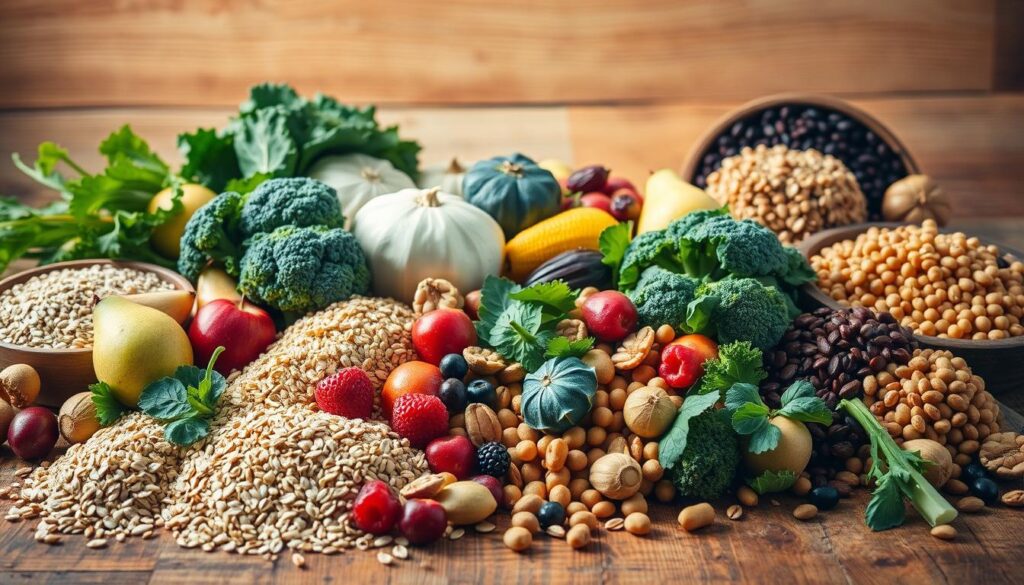
Top whole food sources legumes, whole grains fruits vegetables
Start with legumes like lentils, black beans, and chickpeas. They deliver protein and steady energy. Whole grains such as oats barley quinoa, and whole wheat pasta add bulk and help you stay satisfied.
Fruits and vegetables round it out. Raspberries pears apples, and oranges offer quick portable options. Artichokes broccoli, Brussels sprouts, and carrots bring crunch and depth to a fiber-rich diet.
Nuts, seeds and unconventional high fiber foods
Chia and flax pack dense fiber and healthy fats. Almonds and pistachios add a crisp bite and support balanced snacking with high fiber foods.
Try unconventional picks to diversify fiber intake: green bananas and cooked then cooled potatoes or rice for resistant starch high fiber pastas made with pulses, and roasted chickpea snacks for on-the go crunch.
Reading labels: identifying fiber per serving
Check the Nutrition Facts panel. A good source has at least 3 g of fiber per serving 5 g or more is excellent. Scan ingredient lists for clear whole grains like 100% whole wheat oats or barley.
Note added fibers such as inulin, chicory root fiber, or soluble corn fiber. These can lift numbers fast, but tolerance varies. Choose products that fit your healthy eating goals and keep high fiber foods in steady rotation across meals.
| Category | Example Foods | Approx. Fiber per Serving | Why It Helps |
|---|---|---|---|
| Legumes | Lentils, black beans, chickpeas | 7–15 g per cup cooked | Boosts fullness and supports steady energy on a fiber-rich diet |
| Whole Grains | Oats, barley, quinoa, whole-wheat pasta | 3–10 g per serving | Adds bulk and texture for healthy eating with sustained satiety |
| Fruits | Raspberries, pears, apples, oranges | 3–8 g per cup or piece | Convenient high-fiber foods that pair well with meals or snacks |
| Vegetables | Artichokes, broccoli, Brussels sprouts, carrots | 3–10 g per cup cooked | Delivers diverse fibers and micronutrients to raise fiber intake |
| Nuts & Seeds | Chia, flax, almonds, pistachios | 3–10 g per ounce or 2 Tbsp | Concentrated fiber and healthy fats for balanced hunger control |
| Unconventional | Green bananas, cooled potatoes or rice, high-fiber pasta | 3–8 g per serving | Resistant starch sources that broaden the spectrum of high fiber foods |
Smart Strategies to Increase Fiber Intake Safely
Start low and build slow. Raise fiber intake by about 3–5 grams every few days so your gut has time to adapt. Spread those grams across meals and snacks to support steady energy and a smoother glycemic response. Pair each bump with water until urine stays clear and pale.
Mix fiber types through the day for broader dietary fiber benefits. Aim for viscous options at breakfast like oats or a spoon of psyllium choose mixed fibers at lunch with a bean and grain bowl and load dinner with fibrous vegetables. This approach aligns with current nutrition trends while keeping healthy eating practical.
Use simple kitchen swaps. Choose whole-wheat pasta over refined, stir chia or ground flax into yogurt, add black beans to chili, and pile spinach peppers and tomatoes into sandwiches. Batch cook lentils, farro, and brown rice on Sunday so fiber maxxing fits busy weekdays.
If your stomach is sensitive, begin with gentler picks such as oats, white or brown rice, carrots, and zucchini. Increase textures and portions as comfort improves. Keep sips of water handy pause if bloating rises, and resume with smaller steps.
- Increase by 3–5 g every few days, not all at once.
- Distribute fiber across breakfast lunch, dinner, and snacks.
- Hydrate until urine is clear and pale to reduce cramping.
- Combine viscous, mixed, and vegetable fibers for a balanced plate.
- Pre-cook legumes and whole grains to stay consistent.
Sample day: Overnight oats with berries a quinoa chickpea bowl with arugula at lunch salmon roasted broccoli, and sweet potato at dinner an apple with peanut butter as a snack. This steady pattern supports dietary fiber benefits while keeping flavor front and center.
Fiber Rich Recipes and Meal Ideas
Build a week of flavor-forward plates that underscore healthy eating volume, and texture. These fiber-rich recipes spotlight high fiber foods that support steady energy and satiety aligning with a fiber-rich diet and the goals of fiber and weight loss.
High fiber breakfasts that keep you full
Start with steel-cut oats simmered until creamy, then top with chia and fresh berries. The mix adds chew sweetness, and fiber in every bite.
Try whole-grain toast crowned with ripe avocado and a sprinkle of hemp seeds. A pinch of sea salt and lemon brightens the plate while boosting fiber.
A Greek yogurt parfait layers high-fiber cereal and sliced pear for crunch and lift. Or blend a smoothie with spinach, ground flax, and frozen raspberries for a cold, thick sip.
Lunch and dinner builds bowls soups and salads
Lentil and barley soup offers deep body and comfort. Carrots, celery, and garlic build aroma while delivering more fiber.
Create a quinoa black bean and roasted vegetable bowl with salsa and cabbage slaw. Add lime and cilantro for snap, and you get high fiber foods that stay exciting.
Chickpea pasta primavera tosses al dente noodles with peas, broccoli, and olive oil. A farro salad with kale, apple walnuts, and vinaigrette adds crunch and balance.
Snacks and desserts that boost daily fiber
Keep air popped popcorn, edamame, and roasted chickpeas on hand for quick savory bites. An apple with peanut butter brings crisp texture and staying power.
For dessert, stir chia pudding with cocoa and orange zest then chill until set. A square of dark chocolate with almonds and dried figs caps the day with fiber and satisfaction.
Across these fiber-rich recipes, focus on color bite, and aroma. This approach supports a fiber-rich diet, encourages healthy eating, and can aid fiber and weight loss without feeling restrictive.
Fiber Supplements When and How to Use Them
Whole foods should lead your fiber intake, yet targeted fiber supplements can fill gaps. Used well, they add dietary fiber benefits for appetite control and digestive health without derailing this health trend.
Start low and go slow. Add one product at a time. Sip water with each dose, then assess how you feel over a week before changing anything.
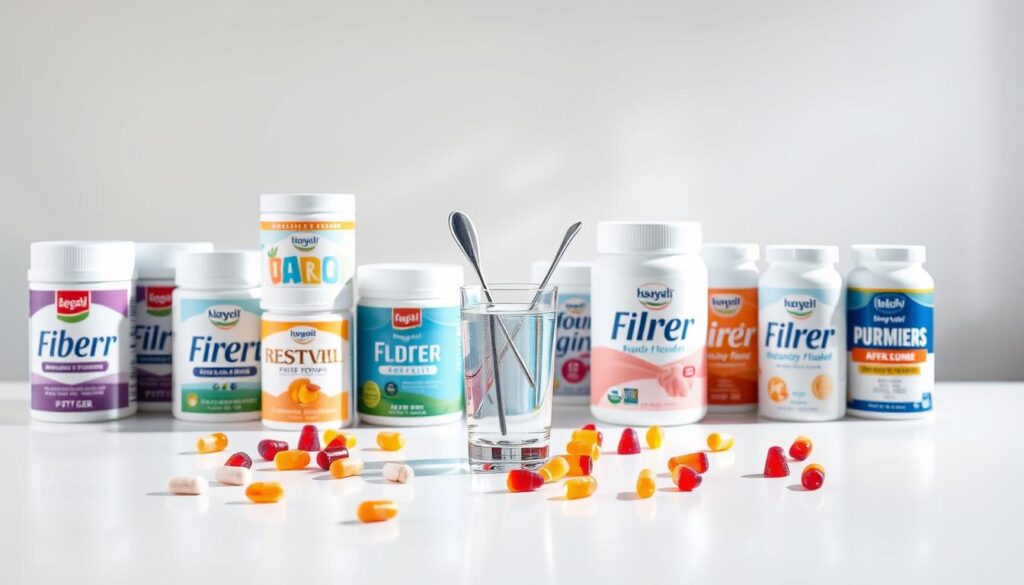
Read more: Need Fiber Supplements? 7 Signs to Watch For
Types psyllium inulin, methylcellulose resistant starch
Psyllium husk forms a gel that helps with regularity. It is backed by research for LDL reduction and steadier glucose supporting digestive health and cardiometabolic goals.
Inulin from chicory root is a fermentable prebiotic. It can boost beneficial microbes but may cause gas in some people. Consider tiny test doses first.
Methylcellulose is non-fermentable and gentler for many. It supports regularity with less bloating, a practical tool when fiber intake from food falls short.
Resistant starch, such as raw potato starch or green banana flour, feeds butyrate-producing microbes. It is a useful add-on in a modern health trend focused on dietary fiber benefits.
Timing, dosing, and hydration tips
- Begin with small doses: 1/2–1 teaspoon psyllium or 3–5 g resistant starch.
- Drink 8–12 oz of water with each serving to support safe swelling and smoother transit.
- Time near meals for satiety and post-meal lipid or glucose support adjust if you notice discomfort.
- Increase only after 3–4 days without new symptoms. Keep other fiber supplements steady while you test.
Who may benefit and who should be cautious
- May benefit: people who miss fiber targets through food, those with elevated LDL cholesterol, or anyone seeking steadier appetite.
- Be cautious: individuals with swallowing problems or GI strictures those with significant IBS symptoms may react to fermentable fibers like inulin.
- Separate fiber and medications by at least 2 hours when advised ask your clinician if unsure.
| Type | Main Action | Best Use Case | Typical Starting Dose | Hydration Need | Potential Drawbacks |
|---|---|---|---|---|---|
| Psyllium Husk | Gel-forming supports LDL and glucose control | Regularity, cardiometabolic support, meal satiety | 1/2–1 tsp with food | 8–12 oz water per dose | Fullness if overused must separate from some meds |
| Inulin Chicory Root | Fermentable prebiotic feeds gut microbes | Microbiome support in tolerant users | 1–2 g with food | 8–12 oz water per dose | Gas or bloating in sensitive individuals |
| Methylcellulose | Non-fermentable softens and bulks stool | Regularity with less gas | Follow label start at lowest scoop | 8–12 oz water per dose | Less impact on lipids or glucose than psyllium |
| Resistant Starch | Feeds butyrate producers supports gut lining | Microbiome and digestive health support | 3–5 g per day | 8–12 oz water per dose | Excess can cause bloating increase gradually |
Used with care and steady hydration fiber supplements can raise daily fiber intake while preserving comfort and routine. Track how you respond, keep portions modest, and build from there to capture meaningful dietary fiber benefits.
Fiber Maxxing for Digestive Health and Sensitive Stomachs
Fiber maxxing can support digestive health when tailored to a sensitive gut. Start low and slow. Favor a gentle, lower FODMAP base with oats, white rice, quinoa carrots zucchini, and firm bananas. If gas is an issue, a non-fermentable option like methylcellulose may help regularity without extra bloating.
Build a gradual path toward a fiber-rich diet. Cook vegetables until tender and peel skins at first. Reintroduce raw greens cruciferous vegetables and allium rich foods in small steps as you tolerate them. Keep portions modest and spread them across the day to smooth the workload on your gut.
Legumes are potent high-fiber foods. Rinse canned beans well and begin with lentils, which many find easier. Increase by a few tablespoons at a time. Track your response so you can adjust before discomfort escalates.
Hydration is essential for healthy eating with more fiber. Sip water throughout the day and time fiber away from new supplements or medications unless a clinician advises otherwise. Consider probiotics only if indicated after reviewing your history and current symptoms.
Use a brief symptom log to personalize fiber maxxing. Note fiber type, dose, cooking method, timing, and any GI effects. For ongoing issues, partner with a registered dietitian who works with IBS or post-illness recovery to refine your plan while protecting digestive health.
Tracking Progress From Fiber Intake to Health Outcomes
Turn daily choices into measurable wins. Align your plan with fiber intake recommendations while keeping the spirit of healthy eating and current nutrition trends. Simple templates help: include one legume one whole grain, and two plant sides each day to support steady fiber intake and the health benefits of fiber.
Using apps and labels to monitor fiber
Use nutrition apps like MyFitnessPal, Cronometer, or Lose It! to log fiber grams per food and per meal. Scan labels and record servings to track progress toward 14 grams per 1,000 calories or age-and-sex AI targets. Compare days and meals to see which choices lift your total and fit your fiber intake recommendations.
Keep a quick log of your go-to items. Whole-wheat pasta, black beans, raspberries, chia seeds, and oats make it easy to hit your goal. Review weekly trends and adjust portions so your fiber intake climbs without extra calories.
Biofeedback satiety energy and GI comfort
Watch how your body responds. Stronger satiety between meals, steadier energy, and Bristol Stool Chart types 3–4 signal that your plan is working. If you feel bloated shift timing increase water and mix sources oats and psyllium for soluble fiber vegetables and wheat bran for insoluble to preserve the health benefits of fiber while keeping comfort high.
Check objective markers when available. Many people see lower LDL on labs and better after-meal comfort when their fiber intake matches fiber intake recommendations. These results align with modern nutrition trends that link healthy eating with practical tracking.
When to consult a registered dietitian or clinician
Seek care if GI discomfort persists if you have inflammatory bowel disease or celiac disease or if medications may interact with fiber. A registered dietitian can set therapeutic targets for lipids and glucose and tailor sources and timing.
Periodic labs can document change LDL-C, A1C and weightnso your plan reflects both your goals and the proven health benefits of fiber. This guidance helps you sustain healthy eating while keeping your fiber intake aligned with evidence-based fiber intake recommendations and evolving nutrition trends.
Conclusion
Fiber Maxxing brings strong science into daily life. It blends meal planning with simple habits to close U.S. fiber gaps.
By leaning on beans whole grains fruits, and vegetables this approach turns healthy eating into a steady routine rather than a fleeting nutrition craze. It also answers the question many readers ask: What exactly is Fiber Maxxing the new nutrition craze? It is a practical, plant-forward method built on evidence not hype.
The core moves are clear and doable. Add fiber slowly, drink enough water and consider targeted supplements like psyllium when food alone falls short.
These steps support digestive comfort satiety, and key cardiometabolic markers such as cholesterol glucose, and blood pressure. In short you get the most from dietary fiber benefits without risking bloat or discomfort.
Personalization makes the plan stick. Track your intake, notice how full you feel, and watch energy and GI comfort over time. Adjust portions timing, and food choices to match your needs and preferences. This turns fiber maxxing into a sustainable pattern rather than a short-term push.
Set within broader plant-forward trends in the United States, fiber maxxing offers a flexible path for many eating styles from Mediterranean to flexitarian.
When paired with smart shopping and simple cooking it elevates healthy eating while staying practical. The result is a durable upgrade to everyday meals and a clear way to capture the full spectrum of dietary fiber benefits in a modern nutrition craze.
